What We’re Reading: May 4th
Review: A newly proposed plastid: the xyloplast ($)
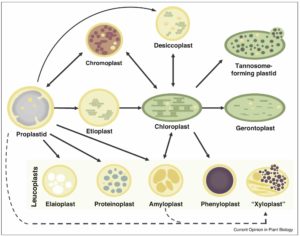 In its simplest definition, a plastid is an organelle that manufactures and stores essential chemical compounds used by its host cell. Numerous plastids exist beyond the familiar chloroplast. Chromoplasts synthesise and store carotenoid pigments, and provide their hosts with district yellow, orange or red colouring, while amyloplasts lack pigment but synthesise and store starch granules by polymerizing glucose. Others, such as gerontoplasts, elaioplasts and proteinoplasts also exist, all derived from the same proplastids that develop into chloroplasts in green plant tissues. Recently, Pinard and Mizrachi proposed a new specialized plastid, the xyloplast, which is found in the secondary vascular tissues of plants and is responsible for synthesising the aromatic amino acid precursors for monolignol production. The phenolic polymer lignin, which provides wood with its resistance to decay, mechanical strength and water transport effectiveness, is produced through polymerization reactions of monolignols in the secondary cell wall. The xyloplast is, therefore, vital to plant secondary growth, and given the importance of wood in global carbon cycling, the dearth of research into plastid biology in xylogenesis is surprising. Since enhanced knowledge of the role of plastids in secondary growth will greatly aid our overall understanding of plant vasculature and development, more research into this exciting topic is crucial. (Summary by Danielle Roodt Prinsloo) Curr. Opin. Plant Biol. 10.1016/j.pbi.2018.01.011
In its simplest definition, a plastid is an organelle that manufactures and stores essential chemical compounds used by its host cell. Numerous plastids exist beyond the familiar chloroplast. Chromoplasts synthesise and store carotenoid pigments, and provide their hosts with district yellow, orange or red colouring, while amyloplasts lack pigment but synthesise and store starch granules by polymerizing glucose. Others, such as gerontoplasts, elaioplasts and proteinoplasts also exist, all derived from the same proplastids that develop into chloroplasts in green plant tissues. Recently, Pinard and Mizrachi proposed a new specialized plastid, the xyloplast, which is found in the secondary vascular tissues of plants and is responsible for synthesising the aromatic amino acid precursors for monolignol production. The phenolic polymer lignin, which provides wood with its resistance to decay, mechanical strength and water transport effectiveness, is produced through polymerization reactions of monolignols in the secondary cell wall. The xyloplast is, therefore, vital to plant secondary growth, and given the importance of wood in global carbon cycling, the dearth of research into plastid biology in xylogenesis is surprising. Since enhanced knowledge of the role of plastids in secondary growth will greatly aid our overall understanding of plant vasculature and development, more research into this exciting topic is crucial. (Summary by Danielle Roodt Prinsloo) Curr. Opin. Plant Biol. 10.1016/j.pbi.2018.01.011
Review: Auxin: a molecular trigger of seed development ($)
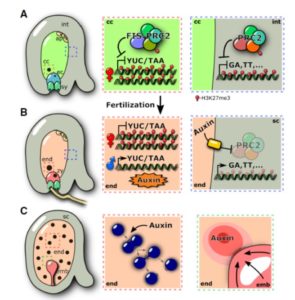 Seeds are hugely important, providing the opportunity for reproductive dormancy in seed-bearing plants and as a nutrient-dense food source for animals. Seed development involves the formation of three genetically distinct tissues, the embryo, seed coat and endosperm. Although normally dependent on fertilization by pollen, through the process of apomixis sometimes seeds can form in the absence of fertilization. Apomictic Arabidopsis mutants known as fertilisation-independent seeds (fis) have contributed to our understanding of this process. Figueiredo and Köhler review the role of auxin and epigenetic control of gene expression in seed development and apomixis. (Summary by Mary Williams) Genes Devel. 10.1101/gad.312546.118
Seeds are hugely important, providing the opportunity for reproductive dormancy in seed-bearing plants and as a nutrient-dense food source for animals. Seed development involves the formation of three genetically distinct tissues, the embryo, seed coat and endosperm. Although normally dependent on fertilization by pollen, through the process of apomixis sometimes seeds can form in the absence of fertilization. Apomictic Arabidopsis mutants known as fertilisation-independent seeds (fis) have contributed to our understanding of this process. Figueiredo and Köhler review the role of auxin and epigenetic control of gene expression in seed development and apomixis. (Summary by Mary Williams) Genes Devel. 10.1101/gad.312546.118
Review: The road to auxin-dependent growth repression and promotion in apical hooks
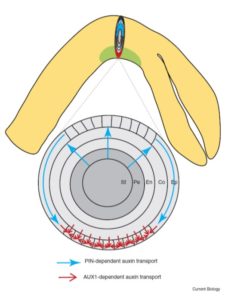 We often hear that auxin controls plant growth. In a special issue of Current Biology focused on membranes, Béziat and Kleine-Vehn observe that due to its role in controlling the distribution of auxin transporters (and therefore auxin), it is also reasonable to say that vesicle trafficking controls plant growth. The authors demonstrate the significance of vesicle trafficking by focusing on the development, maintenance and opening of the apical hook, which is formed through differential growth following asymmetric auxin distribution. The authors also observe that the apical hook is a great model system in which to study plant growth regulation. (Summary by Mary Williams) Curr. Biol. 10.1016/j.cub.2018.01.069
We often hear that auxin controls plant growth. In a special issue of Current Biology focused on membranes, Béziat and Kleine-Vehn observe that due to its role in controlling the distribution of auxin transporters (and therefore auxin), it is also reasonable to say that vesicle trafficking controls plant growth. The authors demonstrate the significance of vesicle trafficking by focusing on the development, maintenance and opening of the apical hook, which is formed through differential growth following asymmetric auxin distribution. The authors also observe that the apical hook is a great model system in which to study plant growth regulation. (Summary by Mary Williams) Curr. Biol. 10.1016/j.cub.2018.01.069
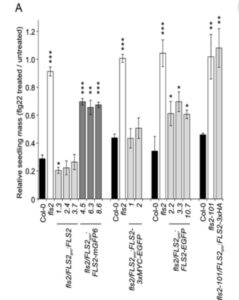 A protein’s function and localization are often studied by fusing it to a small “tag” to enhance visualization (through the tag’s fluorescence or antibodies that recognize the tag). These tags are often assumed to have little effect on the protein of interest, but as Hurst et al. show using several different tags fused to the receptor-like kinase FLS2, this is not always the case. They assay the ability of FLS2 tagged with four different epitopes to complement fls2 mutants, and find that the results are unpredictable but indicate impaired FLS2 function. (Summary by Mary Williams) Plant Physiol. 10.1104/pp.17.01700
A protein’s function and localization are often studied by fusing it to a small “tag” to enhance visualization (through the tag’s fluorescence or antibodies that recognize the tag). These tags are often assumed to have little effect on the protein of interest, but as Hurst et al. show using several different tags fused to the receptor-like kinase FLS2, this is not always the case. They assay the ability of FLS2 tagged with four different epitopes to complement fls2 mutants, and find that the results are unpredictable but indicate impaired FLS2 function. (Summary by Mary Williams) Plant Physiol. 10.1104/pp.17.01700
Genomic variation in 3,010 diverse accessions of Asian cultivated rice
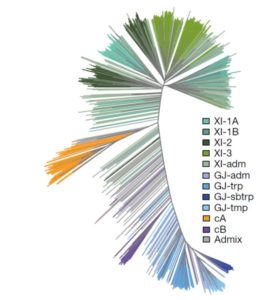 Wang et al. analyse data from the 3000 rice (Oryza sativa) genome (3K-RG) project, identifying “29 million single nucleotide polymorphisms, 2.4 million small indels and over 90,000 structural variations”. The data of course strongly support the two major rice types (Indica and Japonica), but also reveal a total of nine subpopulations. The authors use these data to assemble a rice “pan- genome” comprising all known rice genes. Their data also support multiple different domestication events. Finally, the authors note many genomic structural variations between the Indica and Japonica types which may contribute to their frequently observed hybrid sterility. (Summary by Mary Williams) Nature 10.1038/s41586-018-0063-9
Wang et al. analyse data from the 3000 rice (Oryza sativa) genome (3K-RG) project, identifying “29 million single nucleotide polymorphisms, 2.4 million small indels and over 90,000 structural variations”. The data of course strongly support the two major rice types (Indica and Japonica), but also reveal a total of nine subpopulations. The authors use these data to assemble a rice “pan- genome” comprising all known rice genes. Their data also support multiple different domestication events. Finally, the authors note many genomic structural variations between the Indica and Japonica types which may contribute to their frequently observed hybrid sterility. (Summary by Mary Williams) Nature 10.1038/s41586-018-0063-9
Genome-wide excision repair in Arabidopsis is coupled to transcription and reflects circadian gene expression patterns
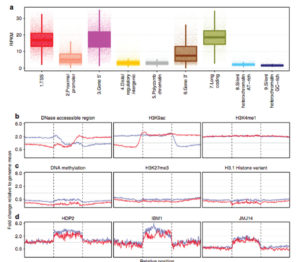 Exposure to ultraviolet radiation and numerous other factors can cause mispairing of the nucleotides in the DNA, compromising genome integrity. Luckily, plants employ excision repair systems to recognize and repair such DNA damage. Oztas et al. examined the dynamics of such a repair system by using excision repair-sequencing method (XR-seq) to identify genome-wide excision repair maps at different time of the day. The authors observed a higher rate of gene repair in the euchromatin compared to silent heterochromatin regions. The dynamic range in repair across the genome overlapped with peak expression of the circadian genes throughout the day, suggesting the prioritization of the repair of the active genes. Whether the enhanced excision repair contributes to better yield and stress tolerance is to be investigated. (Summary by Magdalena Julkowska) Nature Comms. 10.1038/s41467-018-03922-5
Exposure to ultraviolet radiation and numerous other factors can cause mispairing of the nucleotides in the DNA, compromising genome integrity. Luckily, plants employ excision repair systems to recognize and repair such DNA damage. Oztas et al. examined the dynamics of such a repair system by using excision repair-sequencing method (XR-seq) to identify genome-wide excision repair maps at different time of the day. The authors observed a higher rate of gene repair in the euchromatin compared to silent heterochromatin regions. The dynamic range in repair across the genome overlapped with peak expression of the circadian genes throughout the day, suggesting the prioritization of the repair of the active genes. Whether the enhanced excision repair contributes to better yield and stress tolerance is to be investigated. (Summary by Magdalena Julkowska) Nature Comms. 10.1038/s41467-018-03922-5
The yin and yang of salicylic acid perception: The differential roles of NPR proteins in regulating SA signalling ($)
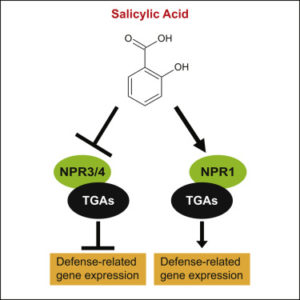 Salicylic acid is a small phenolic hormone that plays a prominent role in the regulation of plant immune responses. Exactly how SA is perceived in planta has been an intensive area of research, with differential paradigms proposed for the perception of SA through negative regulators NPR3/NPR4 or through the master regulator NPR1. In a new study published in Cell, Ding et al. (2018) identified an npr4 mutant allele producing a dominant negative protein that no longer binds SA and is therefore a constitutive repressor of SA signalling. Importantly, the authors demonstrate that rather than acting as a regulator of NPR1 protein stability, NPR4/NPR3 function as co-transcriptional repressors that regulate SA signalling independent of NPR1. Collectively, the data provide an updated model for the perception of SA through the contrasting roles of SA-binding NPR proteins. (Summary by Philip Carella) Cell 10.1016/j.cell.2018.03.044
Salicylic acid is a small phenolic hormone that plays a prominent role in the regulation of plant immune responses. Exactly how SA is perceived in planta has been an intensive area of research, with differential paradigms proposed for the perception of SA through negative regulators NPR3/NPR4 or through the master regulator NPR1. In a new study published in Cell, Ding et al. (2018) identified an npr4 mutant allele producing a dominant negative protein that no longer binds SA and is therefore a constitutive repressor of SA signalling. Importantly, the authors demonstrate that rather than acting as a regulator of NPR1 protein stability, NPR4/NPR3 function as co-transcriptional repressors that regulate SA signalling independent of NPR1. Collectively, the data provide an updated model for the perception of SA through the contrasting roles of SA-binding NPR proteins. (Summary by Philip Carella) Cell 10.1016/j.cell.2018.03.044
Key to success: The fungal MAP kinase Pmk1 controls the intracellular spread of the rice blast fungus Magnaporthe oryzae in rice cells
 Magnaporthe oryzae is a devastating fungal pathogen that routinely threatens rice crop yields. Rice blast infection occurs when fungal hyphae penetrate into and proliferate within living plant cells, moving intracellulary from cell-to-cell through plasmodesmatal junctions. In a recent article published by Sakulkoo et al. (Science), chemical genetics revealed that a single MAP Kinase, Pmk1, is essential for the cell-to-cell spread of fungal hyphae. The authors demonstrated that Pmk1 inhibition rendered fungal hyphae unable to penetrate through plasmodesmata, effectively trapping the pathogen within plant cells. This inhibition was associated with an inability to induce effector gene expression that is normally required to suppress host immunity. Together, the data support a critical role for Pmk1 in regulating the cell-to-cell spread of fungal hyphae through plant cell-cell junctions. (Summary by Philip Carella) Science 10.1126/science.aaq0892
Magnaporthe oryzae is a devastating fungal pathogen that routinely threatens rice crop yields. Rice blast infection occurs when fungal hyphae penetrate into and proliferate within living plant cells, moving intracellulary from cell-to-cell through plasmodesmatal junctions. In a recent article published by Sakulkoo et al. (Science), chemical genetics revealed that a single MAP Kinase, Pmk1, is essential for the cell-to-cell spread of fungal hyphae. The authors demonstrated that Pmk1 inhibition rendered fungal hyphae unable to penetrate through plasmodesmata, effectively trapping the pathogen within plant cells. This inhibition was associated with an inability to induce effector gene expression that is normally required to suppress host immunity. Together, the data support a critical role for Pmk1 in regulating the cell-to-cell spread of fungal hyphae through plant cell-cell junctions. (Summary by Philip Carella) Science 10.1126/science.aaq0892
Adaptive diversification of growth allometry in the plant Arabidopsis thaliana
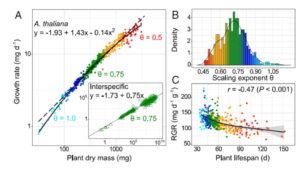 Most students learn that metabolism does not increase at the same rate as an animal’s size – an elephant eats much less per unit of body mouse than a mouse does. This non-linear scaling, described through metabolic scaling theory, also occurs in plants – the growth rate of large plants is relatively slower than that of small plants. The relationship between different facets of growth is known as allometry. To better understand growth allometry in plants, Vasseur et al. examined the relationship between growth rate and final dry mass in 451 Arabidopsis thaliana accessions. They found that although many accessions showed the expected relationship between size and growth rate, some deviated significantly, and that in some cases these deviations (both fast and slow) are correlated with extreme drought tolerance. Analysis of the genetic factors contributing to allometry diversification revealed many genes involved in metabolism and stress responses. They further identifed an important contribution from PUB4, which encodes a U-box protein gene involved in protein turnover, a key regulator of plant responses to abiotic stress. (Summary by Mary Williams) Proc. Natl. Acad. Sci. USA 10.1073/pnas.1709141115
Most students learn that metabolism does not increase at the same rate as an animal’s size – an elephant eats much less per unit of body mouse than a mouse does. This non-linear scaling, described through metabolic scaling theory, also occurs in plants – the growth rate of large plants is relatively slower than that of small plants. The relationship between different facets of growth is known as allometry. To better understand growth allometry in plants, Vasseur et al. examined the relationship between growth rate and final dry mass in 451 Arabidopsis thaliana accessions. They found that although many accessions showed the expected relationship between size and growth rate, some deviated significantly, and that in some cases these deviations (both fast and slow) are correlated with extreme drought tolerance. Analysis of the genetic factors contributing to allometry diversification revealed many genes involved in metabolism and stress responses. They further identifed an important contribution from PUB4, which encodes a U-box protein gene involved in protein turnover, a key regulator of plant responses to abiotic stress. (Summary by Mary Williams) Proc. Natl. Acad. Sci. USA 10.1073/pnas.1709141115



